1946 Half Dollar Coin Value: How Much Is It Worth?
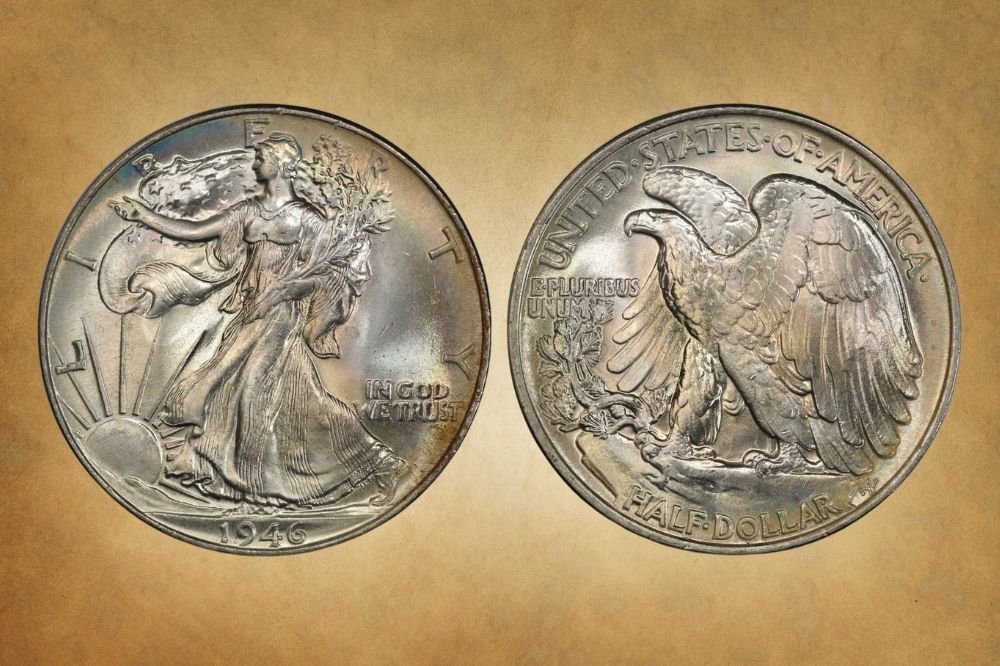
1946 was the penultimate year for Walking Liberty Half Dollars before they were replaced by Franklin Half Dollars in 1948. It was also the first year after the mint stopped producing wartime coins, so it draws a lot of interest from collectors and resellers. Let’s take a closer look at the 1946 Half Dollar value to see how it measures up against coins from others years.
1946 Half Dollar Value Chart |
|||||||
| Mint Mark | Good G 4 | Fine
F 12 |
Extra Fine
XF 20 |
Extremely Fine
EF 40 |
About Uncirculated
AU 50 |
Uncirculated MS 60 | Mint State
MS 63 |
| 1946 (P) No Mint Mark Half Dollar Value | $14 | $18 | $20 | $20 | $23 | $41 | $55 |
| 1946 (P) DDR No Mint Mark Half Dollar Value | $23 | $31 | $45 | $77 | $144 | $317 | $611 |
| 1946-S Half Dollar Value | $14 | $18 | $20 | $20 | $27 | $48 | $66 |
| 1946-D Half Dollar Value | $14 | $18 | $20 | $24 | $39 | $51 | $70 |
1946 Half Dollar Value Guide
We mentioned the mint mark above. All coins are made by the US Mint, but you sometimes see a letter or two that tells you which branch made the coin. Some mints are more valuable than others in the secondary market, so it’s a useful pricing factor. Coins might also have the mint date to show when the coin was released. In some years, this is a crucial value factor.
Why? Because coins aren’t always released in the year they were minted. This could happen for a variety of reasons. The mint might still have excess coins from the prior year, the dies might be re-used if there’s no budget to replace them, or socio-political matters may affect mint volumes and release dates. Now let’s look at the 1946 Half Dollar Value by mint mark.
1946 (P) No Mint Mark Half Dollar Value
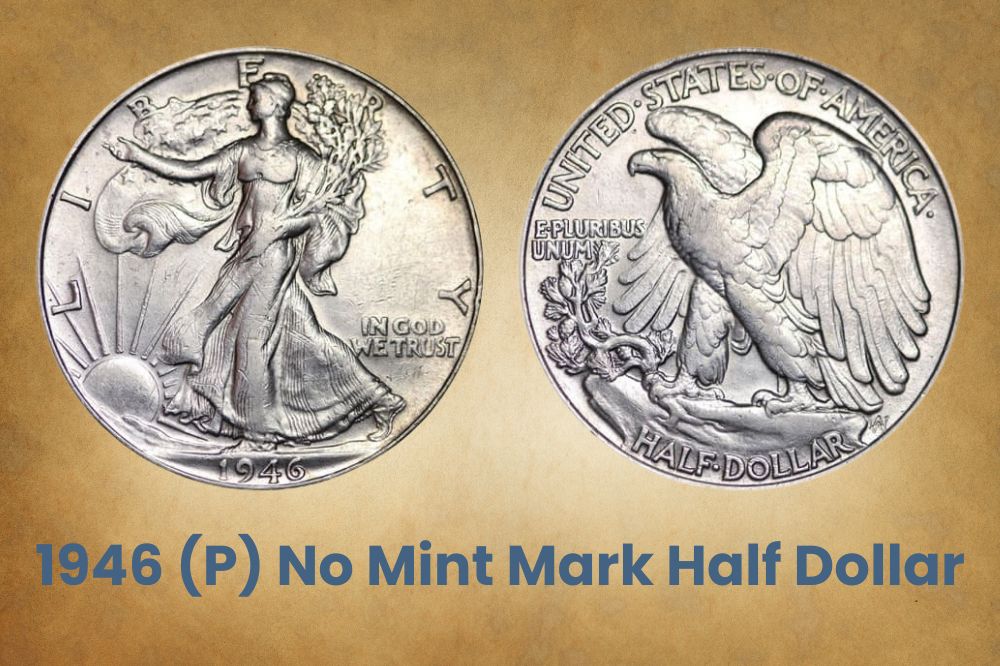
In 1946, the Philadelphia Mint made 12,118,000 Walking Liberty Half Dollars. They had no mint marks. In January 2019, a 1946 (P) Half Dollar sold for $28,200 in MS 67+. Similar coins were auctioned for $15,500 in August 2021, $13,513 in May 2022, and $10,800 in June 2022. PCGS has only graded one coin as MS 68 and estimates its current value at $135,000.
1946-S Half Dollar Value
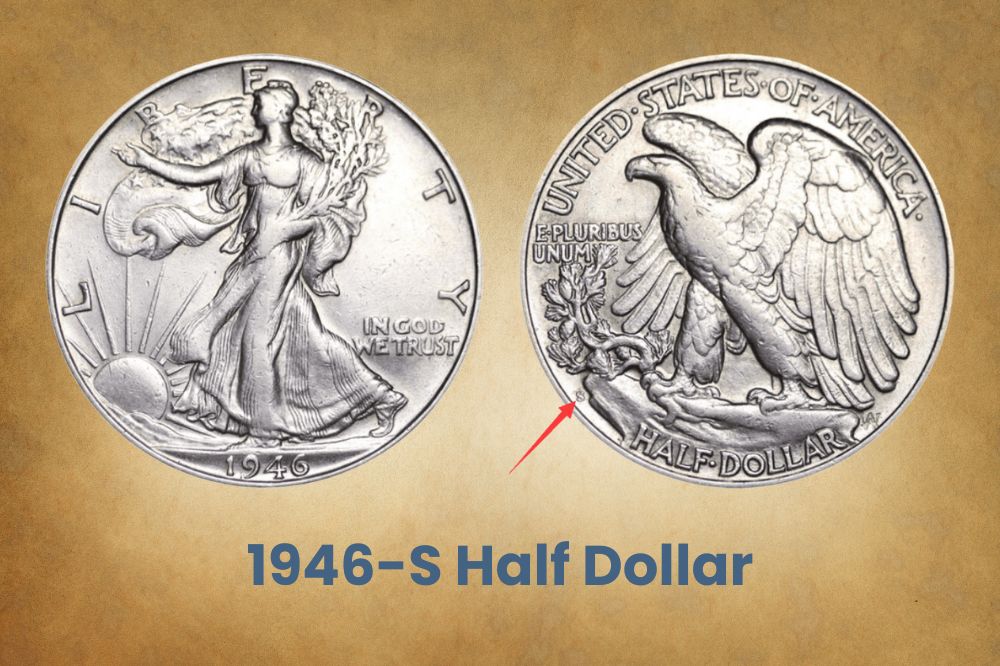
The San Francisco Mint pressed 3,724,000 Walking Liberty Half Dollars in 1946. They all had the S Mint Mark. In June 2021, a 1946-S Half Dollar graded MS 67+ was auctioned for $38,400. PCGS has graded 11 of these coins and estimates their individual value at $36,000. NGC prices are often lower than PCGS and their record auction was $3,120 in April 2019.
1946-D Half Dollar Value
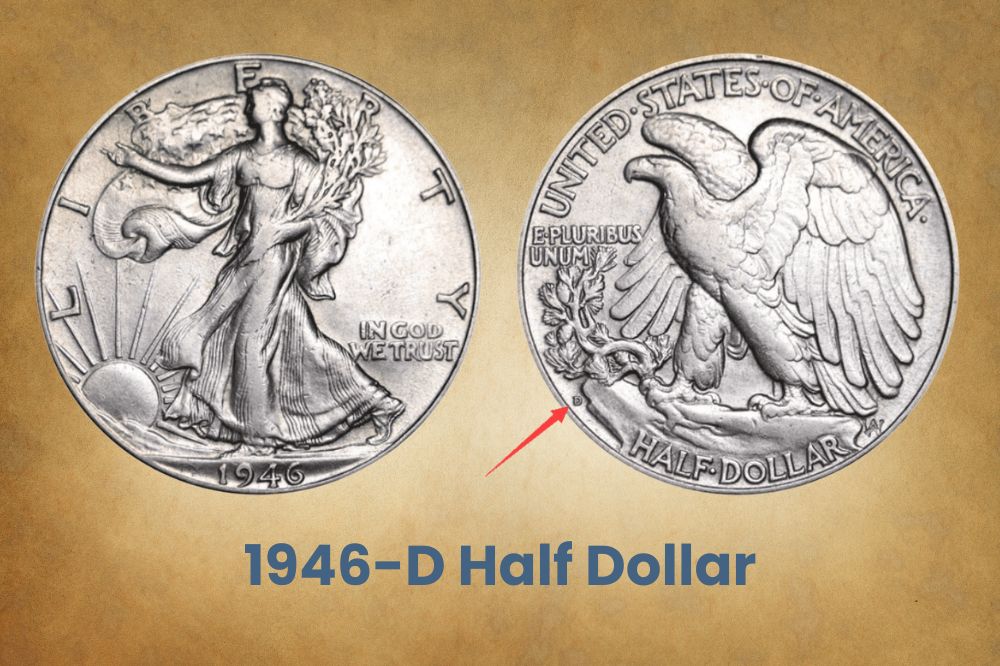
In 1946, the Denver Mint coined 2,151,000 Walking Liberty Half Dollars. They all had the D Mint Mark. In June 2021, a 1946-D Half Dollar graded MS 67+ auctioned for $31,200. PCGS has graded 21 of these coins so far, estimating their current value at $27,500 per piece. In December 2021, one of these coins sold for $21,150. In April 2022, that was down to $18,213.
1946 (P) DDR Half Dollar Value
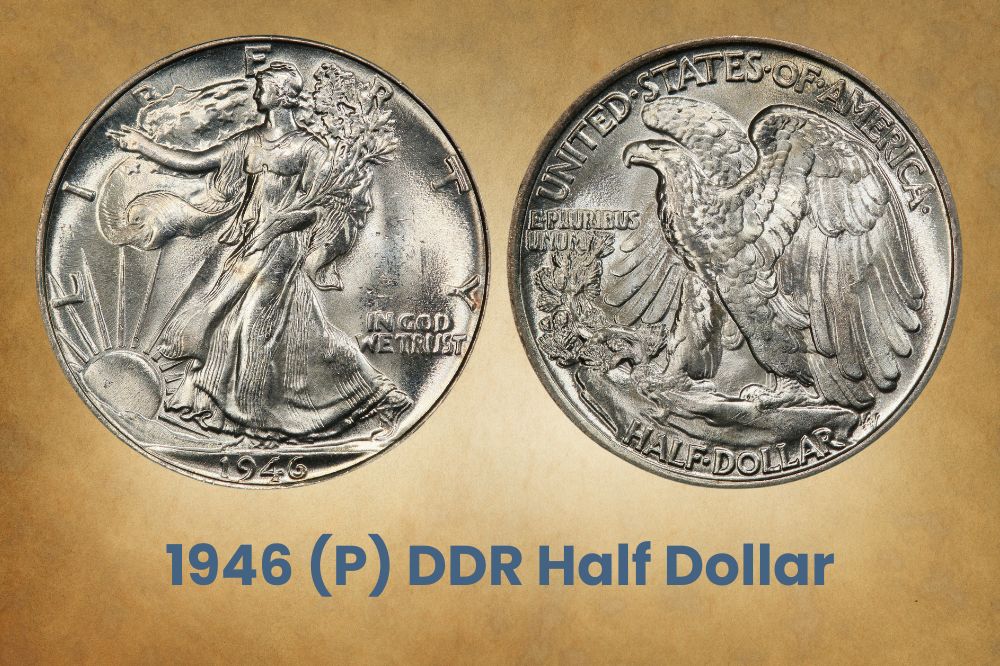
Apart from the mint mark, mint volume, mint date, and rarity, the errors on a coin can raise the resale value of a coin. And some errors are so pricy that they’re categorized separately, such as the 1946 (P) DDR Walking Liberty Half Dollar. DDR means doubled-die reverse, and we’ll discuss that in detail later. For now, let’s look at its approximate values based on coin grades.
It’s not clear how many of these coins were minted, but in MS 66+, this mint error coin was auctioned for $9,400. That was way back in January 2017. PCGS has graded 8 coins as MS 66+ and estimates their current value at $12,500 each. And while an MS 66 DDR is valued at $4,250 by the PCGS Price Guide, a coin in this grade was auctioned for $3,480 in June 2021.
Related Posts: 26 Most Valuable Half Dollar Coins In Circulation
1946 Half Dollar Errors
We’ve mentioned hubs, dies, and planchets, now let’s discuss their role in minting. When an artist designs a new coin, s/he makes an 8” model using plaster, rubber, and epoxy. The mint has a reducing machine that shrinks it down to size. This process takes several days and results in a steel master hub. This hub makes the master die, which makes working hubs.
The working hubs make working dies, and these eventually strike planchets to make coins. All these stages require multiple strikes to ensure clarity and accuracy, so if the metal moves between strikes, you can cause errors like doubling, tripling, off-centers, etc. Each error has a separate premium and can make the coin more valuable, so let’s look at the top prices for some.
1946 Half Dollar DDO Error
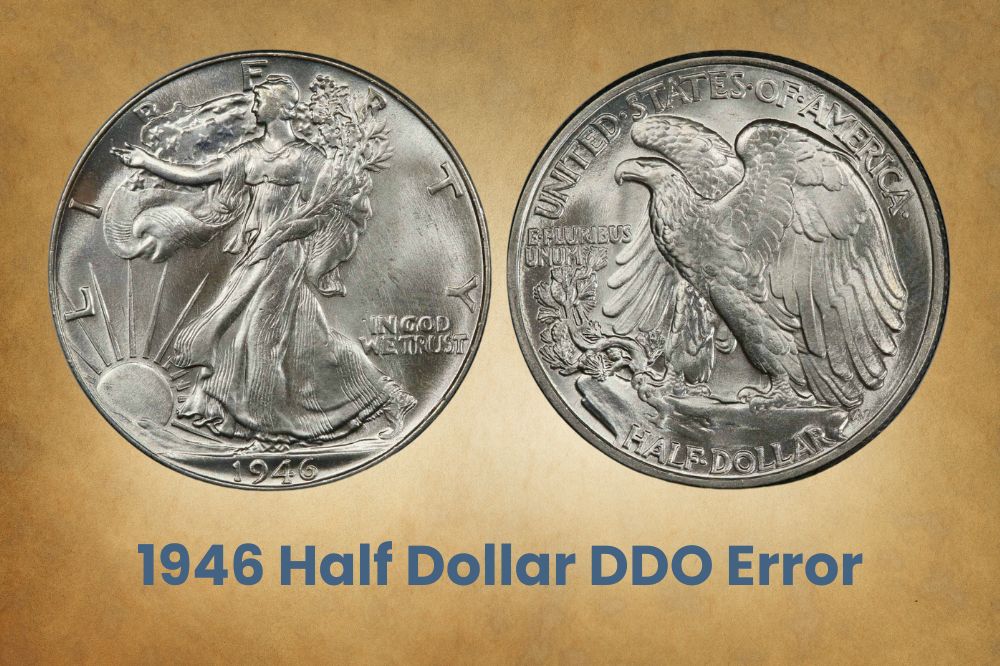
DDO means doubled-die error. It occurs when the die shifts between hub strikes, and it counts as a variety because the flaw will be reproduced on every coin made with that die. The doubling is often clearest on the letters and numbers, so check those with a coin microscope or a jeweler’s loupe. An MS 66 was $2,585 in January 2020. Today’s estimate is $5,000.
1946 Half Dollar DDR Error
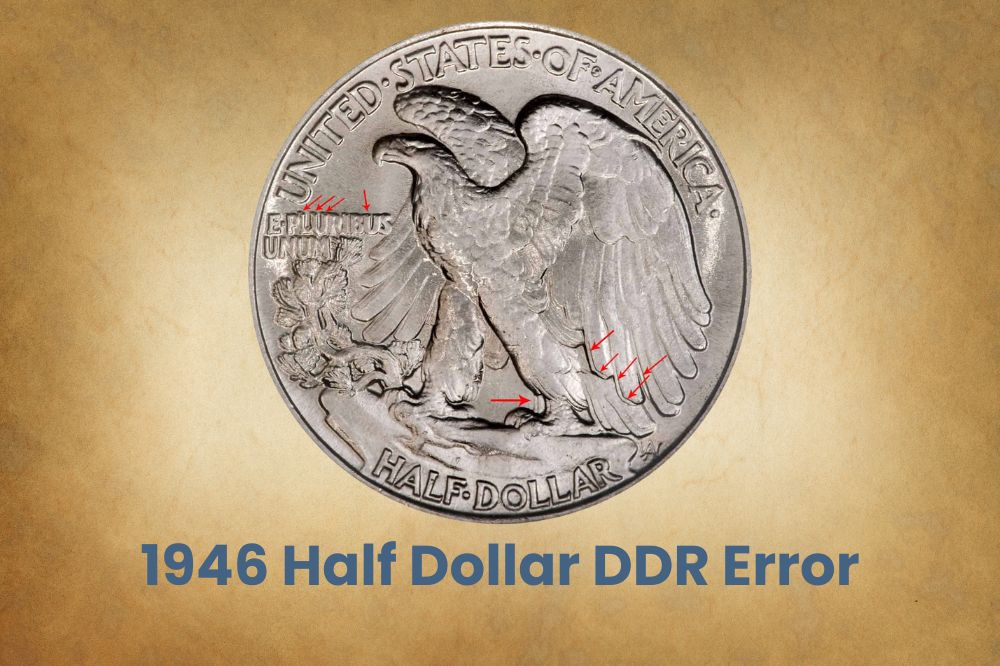
We mentioned the DDR variety earlier, and it’s a doubling error on the back of the coin that happens at the hubbing stage. As we said, the auction record for a 1946 Half Dollar DDR was $9,400 for an MS 66+ back in January 2017, and the PCGS Price Guide quotes $12,500. But since MS 66+ is the highest known grade, you could make more with an MS 67 or higher.
1946-S Half Dollar S/S RPM Error
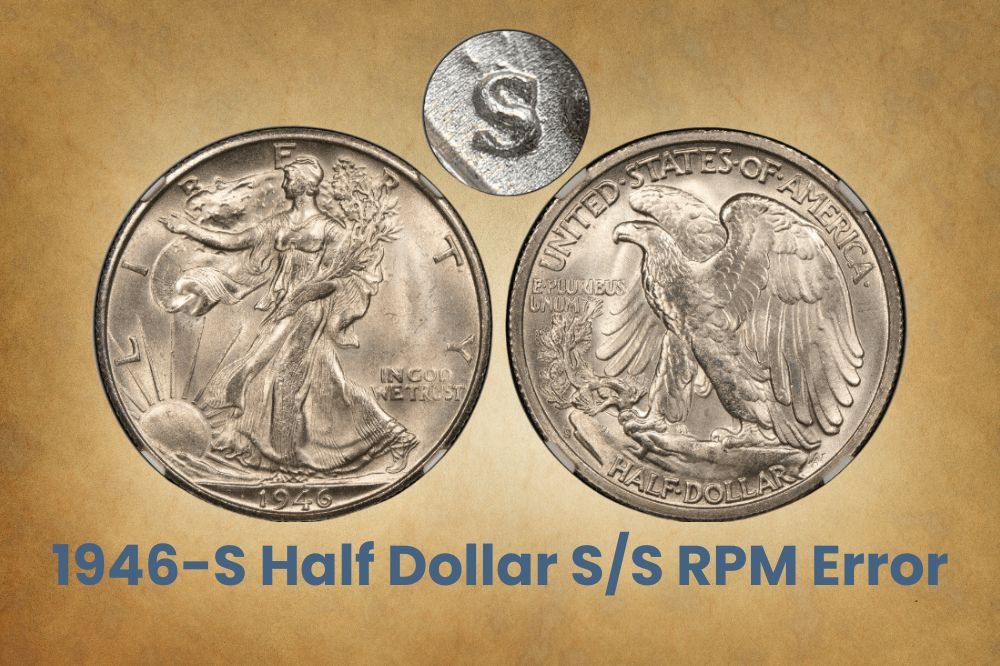
RPM means re-punched mint mark. It’s a doubling error where the second strike of the mint mark lands on a slightly different spot, leaving visible traces of the earlier strike. The mint mark is generally the last feature added to working dies, and until 1989, it was placed with a hand punch so errors were common. In MS 64 this San Francisco RPM sold for over $60.
Related Posts: 17 Most Valuable Kennedy Half Dollar Worth Money
History of the 1946 Half Dollar
The Coinage Act of 1890 dictated – among other things – that if a coin had been in use for 25 years, its design could be changed without express permission from Congress. This wasn’t mandatory, but around 1915, the Mint Director, Robert W. Woolley, started considering it. The Barber Coinage had been used since 1892 and had matching designs on three coins.
The public didn’t really like the coins, and Woolley had misunderstood the requirements, so he took steps to redesign some of these coins through a public contest. The Chief Mint Engraver, Charles Barber, wanted to do the redesigns himself since it was his coins that were being replaced. This process put him at loggerheads with Augustus Saint-Gaudens.
Saint-Gaudens was a popular artist and was among Woolley’s top choices to change these coins. Instead, he and Barber ended up as co-judges for the public contest to pick the new design, and the two couldn’t agree on anything! Their mutual clash continued until 1907 when Saint-Gaudens died, and their opposing views affected lots of other circulating coins.
But after all the kerfuffle, Adolph Alexander Weinman designed the Walking Liberty Half Dollar that was used from 1916 to 1947. He was paid $500 for his contest-winning design, and it carries his monogram, a stylized AW. The visibility of his initials did cause issues, but unlike earlier coin designer Victor David Brenner, Weinman wasn’t forced to remove them.
The Matter of Maker’s Marks on Coins
Why was the insignia such a big deal? Well, earlier coins – including the ones Charles Barber designed – had extremely understated designer’s marks. These coins were made by in-house mint engravers who didn’t necessarily need the extra credit. So they would place their initials somewhere subtle, like the portrait cut-off, or hidden inside the locks of Lady Liberty’s hair.
But when coins were designed through public competitions, winning designers used their work to gain additional commissions, so they would make their insignia larger and more visible. You can see this even on the 50 State Quarters of 1999 to 2008. And this sometimes drew the ire of both the public and mint officials who found the practice too advertorial.
Another issue with the Walking Liberty was the level of detail and relief. It was pretty, but all those extra elements made the coin harder to press. Dies didn’t last as long, details wore down faster in circulation, and the coins cost more to make. They were tired of … “the desire by the government to mint coins to the satisfaction of artists and not practical coiners.”
This was a quote from Adam M. Joyce, the Superintendent of the Philadelphia Mint. But on this occasion, as with the Lincoln Cent, Buffalo Nickel, Mercury Dime, and the Saints by Augustus Saint-Gaudens, the mint’s concerns were overruled in favor of art and aesthetics. As a result, the Walking Liberty Half Dollar is still one of America’s most beautiful coins.
Related Posts: 18 Most Valuable Franklin Half Dollars Worth Money
How to Identify the 1946 Half Dollar?
When you’re working in the coin space, it’s helpful to use the right terminology. This can be confusing at first, but it gives you an air of professionalism and competence when you’re dealing with numismatists and other experts, so let’s get you familiar with the main jargon.
- Numismatist – a person who studies and sometimes collects coins.
- Planchet – the blank disc that gets stamped to make a coin.
- Coin press – the machine where coins are minted.
- Strike – the action of hitting metal to form a coin.
- Die – the steel template that strikes planchets into coins.
- Hub – the steel template used to make dies.
- Obverse – the front or heads side of a coin.
- Reverse – the back or tails side of a coin.
- Edges – the thin side of a coin that can be smooth/plain or ribbed.
- Ribs – the patterned ridges on the edges of some coins.
- Smooth/plain – a coin edge that has no ribs.
- Denticles – the tooth-like ridges along the rims of some coins.
- Rim/Collar – the raised border of a coin.
- Device – the image on a coin.
- Legends/Mottos – the words on a coin.
- Field – the background or backdrop on a coin.
Apart from these terms, you might hear someone refer to mint marks. These are small letters or initials that tell you where the coin was made. Some coins might also have an extra initial or monogram to show you who designed the coin. Let’s get into this coin’s physical features.
The Obverse of the 1946 Half Dollar
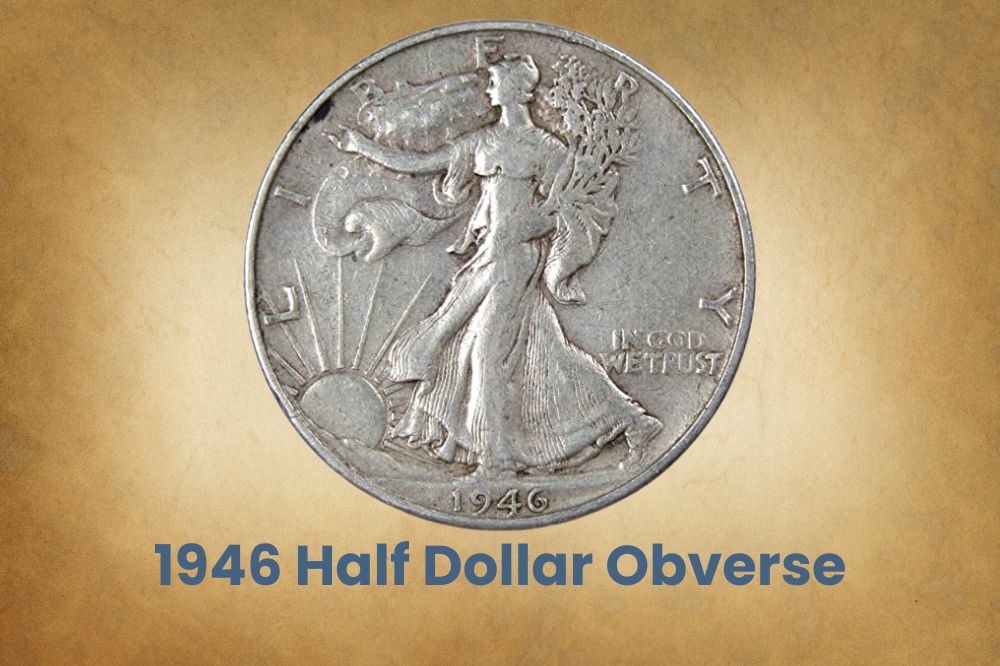
The obverse (heads side) of the 1946 Half Dollar shows Lady Liberty walking towards the sun, which is peeking out of a hill on the lower left side. She’s wearing a flowing dress and a Phrygian Cap aka Liberty Cap. Her left arm is outstretched and she has both laurel and oak branches in her right arm. The US flag flaps over her shoulder on the left, touching sunlight.
On the ground beneath her feet, you can see the mint date. The legend Liberty curls around her from about knee-level and is partially hidden at the top of the coin. On the right side of the coin, behind her rear leg, you can see the motto In God We Trust. The words are slightly below the Y in Liberty. The device covers most of the surface of this Silver Half Dollar coin.
The Reverse of the 1946 Half Dollar
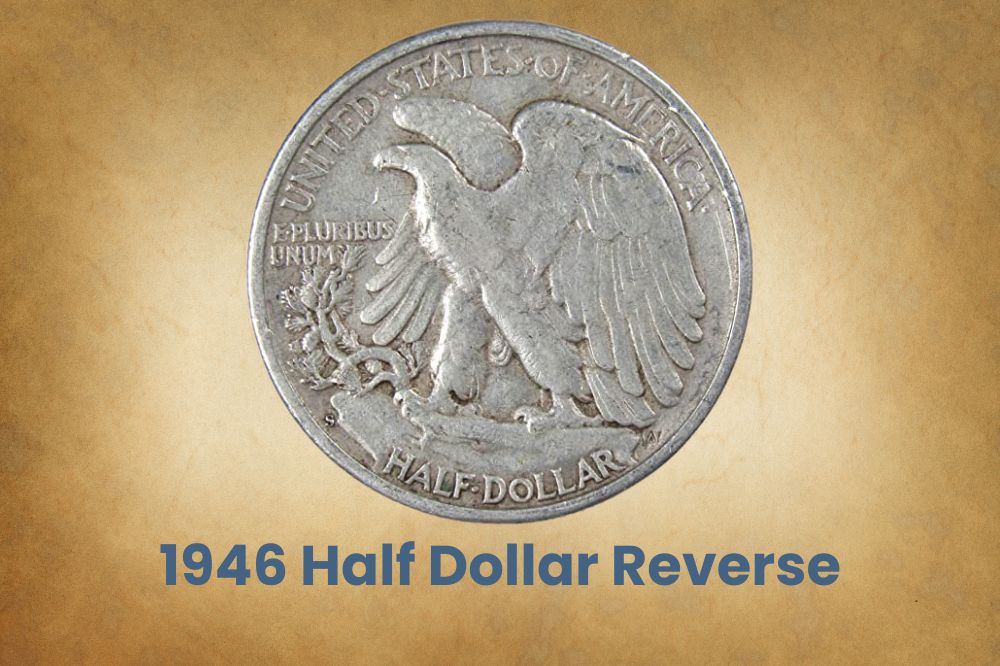
The reverse (tails side) of the 1946 Half Dollar features an eagle that’s opening its wings as it prepares to take flight. One of its legs is stepping forward and holding a mountain pine while its other leg is still perched on the ground. The designer’s monogram, AW, is on the lower right of the coin. The denomination, Half Dollar, is along the lower rim with a dot between.
On the upper right of the coin, above the mountain pine, is the motto E Pluribus Unum with a dot between E and Pluribus. The legend United States of America runs along the upper rim of the coin with dots in between the words, and a final dot after America. The tops of this eagle’s wings are quite closely cropped, grazing the first S in States and the R in America.
Other Features of the 1946 Half Dollar
The mint mark on Walking Liberty Half Dollars was sometimes on the front (1916 and part of 1917) and sometimes on the back. In 1946, it appeared on the lower left reverse, under the tree branch. That’s almost directly opposite the designer’s monogram. The coin itself was 90% silver and 10% copper, weighed 12.5g, and measured 1.8mm thick and 30.63mm across.
It contained about 0.36 troy ounces of silver, and for reference, a troy ounce is a special unit that’s 1.097 of a standard ounce. It’s only used to weigh precious metals aka specie aka silver and gold. The Half Dollar has 150 reeds along its edges. By law, Half Dollars were twice the weight of a quarter and half the weight of a $1, with matching proportions of silver content.
How Much is a 1946 Silver Dollar Worth?
No Silver Dollars were made in 1946. The last Peace Dollar was minted in 1935 and no more were coined until 2021. But the 1946 Silver Half Dollar, a Walking Liberty, is worth $50 to $70 in MS 63. That said, auctions from 2021 ranged from $20,000 to $30,000 for MS 67+.
